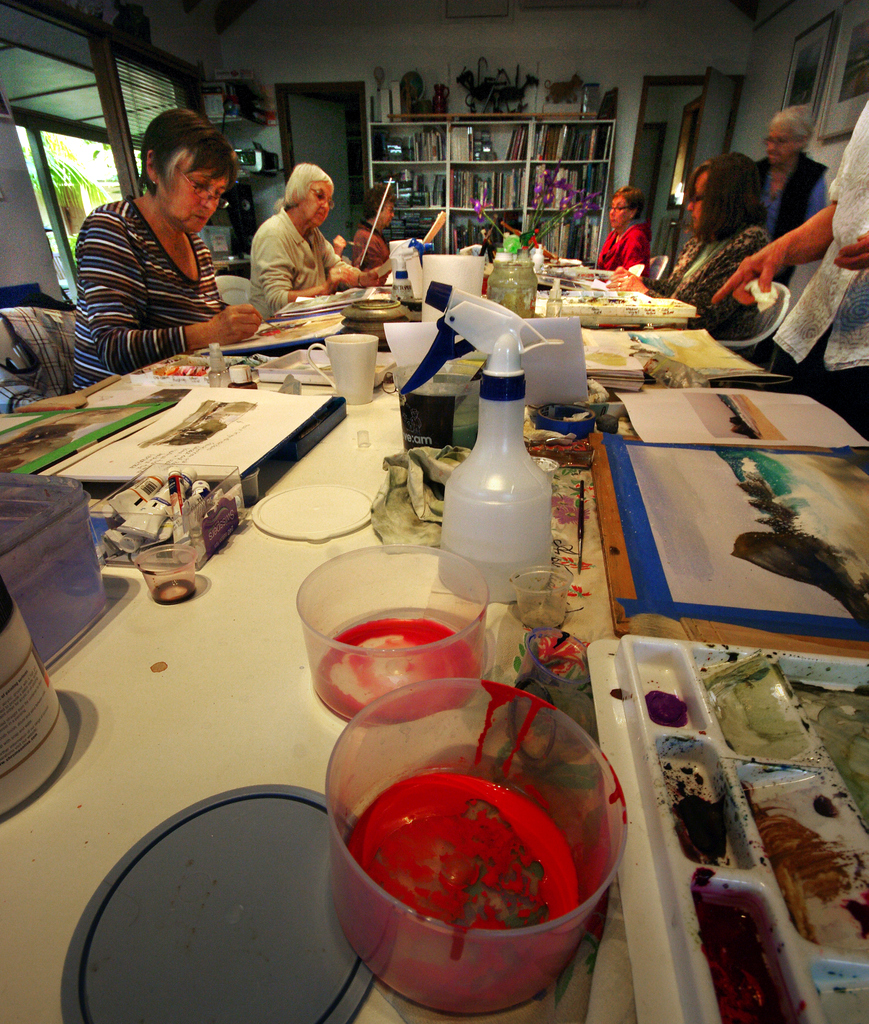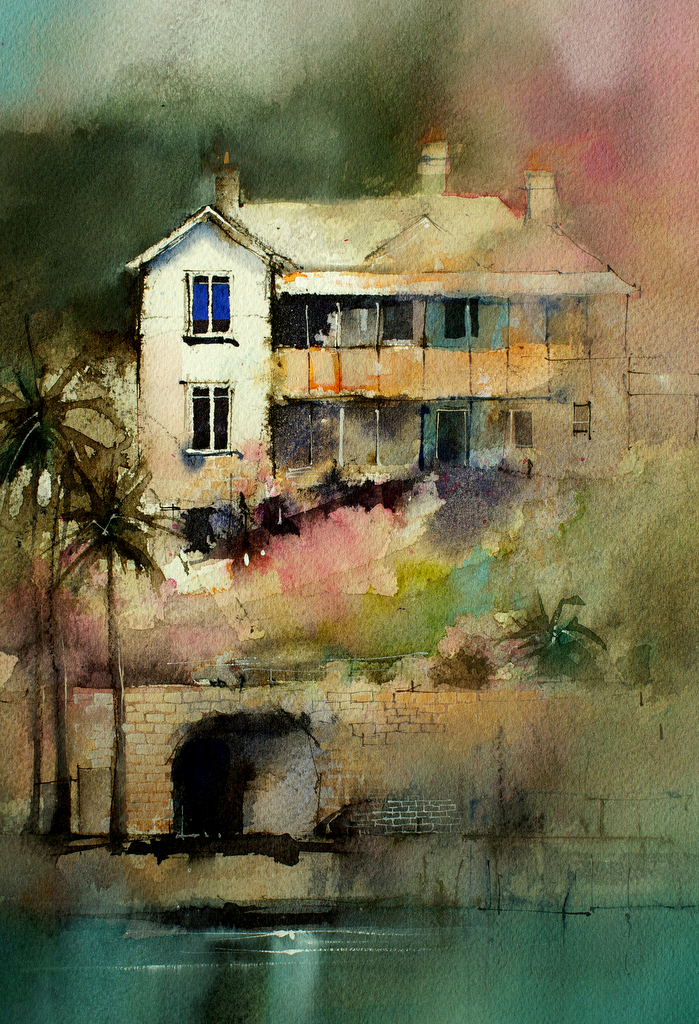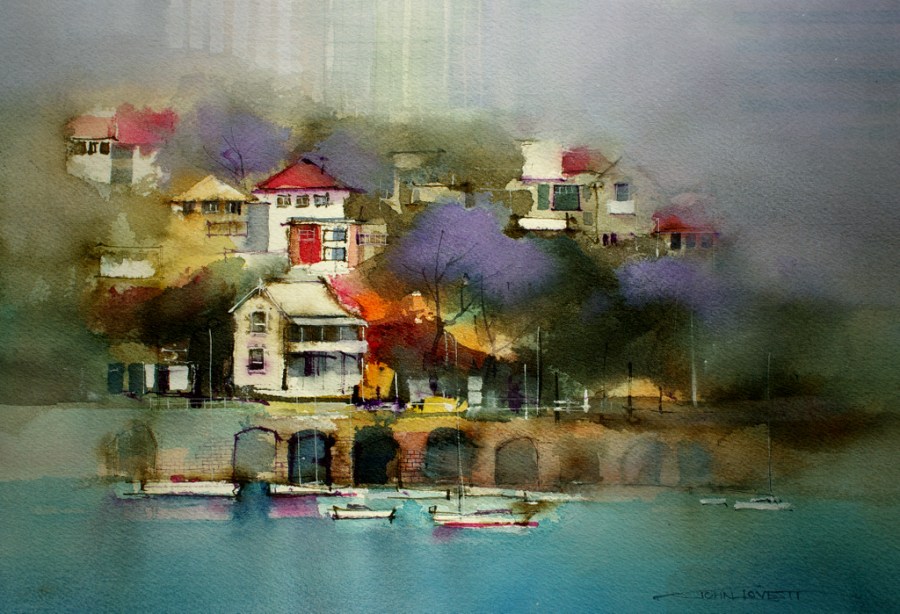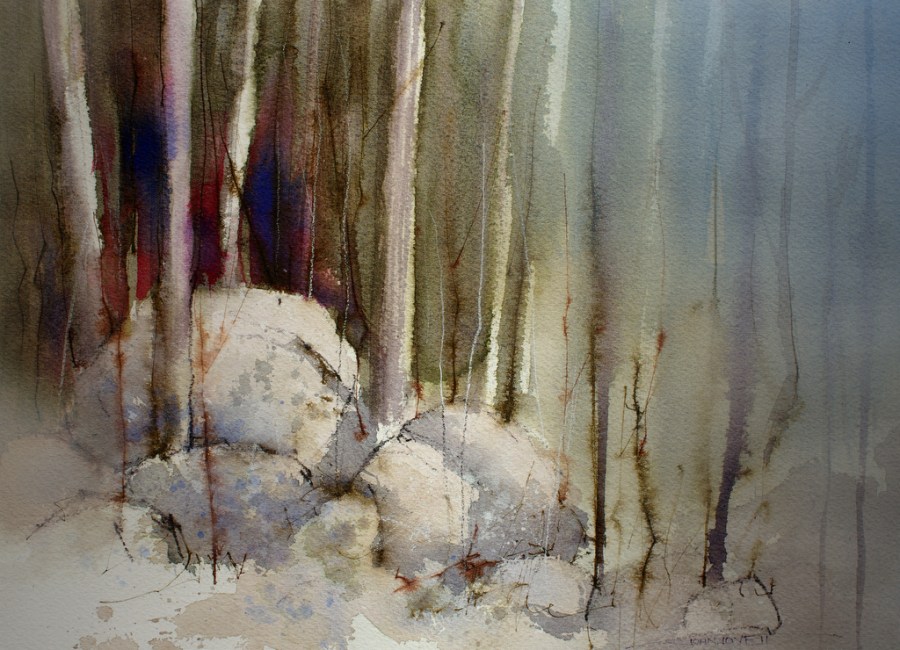We have just finished two full on weeks of workshops in the studio. Some familiar faces and some new faces. This is the first time we have had a completely new group for the second week, so I thought it would be interesting to repeat some of the demonstrations with some variation.
These two landscapes based on recent photos from Western Queensland were started with transparent washes (Quinacridone Gold, Cobalt Blue and Permanent Rose) Then the trees and other details were added with more opaque mixtures of Ultramarine Blue, Phthalo Blue, Alizarin Crimson and Quinacridone Gold. Graded washes were used on either side to create a band of light through the focal point, then various layers of gesso and White gouache glazes were worked through the sky and distance.
I have painted this Old house on Sydney Harbour from various angles and thought it would be a good workshop subject, having problems of symmetry and conflicting focal points to be sorted out.
I was surprised when we started drawing, to find that one of the students had lived in the flat behind the house back in the 70’s – when Brett Whitely lived and painted a little further around the bay.
These paintings were done with the same simple palette of Quinacridone Gold, Alizarin Crimson, French Ultramarine Blue, Phthalo Blue and Permanent Rose. I also used Charcoal pencil, White Gouache, Gesso and Burnt Sienna Ink. The vibrant blue window in the top painting was painted with Ultramarine Gouache.
Not far from Venice is the small fishing port of Chioggia. These weather beaten trawlers make an interesting subject with their confusion of masts and rigging and the complicated backdrop of ancient buildings. The idea here was to suggest all the complicated detail without trying to carefully render it. We started with under washes of Permanent Rose and Aureolin and gradually built up detail over the tinted paper.
A different subject using the same transparent under wash technique. This time graded washes of Cobalt Blue and Permanent Rose formed the under wash.
Painting these Lorrikets was a lot of fun – balancing sharp detail with loose suggestion. The wings and much of the body were roughly washed in with an old 1/2″ bristle brush. Detail was built up around the head and body with a 1/4″ flat brush and a #1 rigger. Finally the wings were attacked with gesso and a white charcoal pencil to get a feeling of movement.
Everyone enjoyed painting these rocks and sapplings. The purpose was to shuffle around the source material to create an interesting composition, then to build up textures and depth with watercolor, gouache, ink, charcoal pencil and Gesso. We used a number of techniques – splashing, splattering and spraying to build up the textures and gesso glazes to soften and push back the distance.
Another exercise in rearranging the subject. This time a soft abstract foreground to lead the eye into the focal point of trees and buildings.
So thanks to everyone that attended the workshops and thanks to Dianne for the mighty cakes – back to dry biscuits now!














Stunning as always John. Congratulations on your beautiful work.
Thanks Christine
these are beautiful. i wish i could use water colours with such ease. (i HATE watercolours)
Hi Scritch,
once you get into watercolor you’ll be hooked!
Great fun and always unpredictable.
Cheers
John
i tried i tried for many years. its not me. my hand or elbow always lands in it somewhere
lovely art work…..
🙂
ivonne
Cheers Ivonne
I love this blog! I have moved from watercolor to “painting” digital photos with apps on my iPhone, but these images made me yearn for the brush again. And I had an ah-ha moment — of course the painter should guide the eye to a focal point as you consistently do. This is your POV! I am often trapped in my paintings trying to make everything representational — what a mistake! Thanks for the insight. -Beth
Hi Beth,
Glad you are enjoying the blog.
The iPhone can really get you in – I spent hours scribbling on the tiny screen, but eventually went back to the low tech brush and paint – Lots of fun though!
Cheers
John
Loved the pictures! Wish I could have been in the class.
Thanks Becki
One investigates thru web, and found John Lovett, buy CDs, learning her techniques, and receive more inspirations (email ) from her studios worshop. So easy!
But I dont have the same fate, I have not tasted the mighty cakes of Diane.
Kind Regards
from Madrid, Spain.
Sergio
Hi Sergio,
The cakes are something else! – We get spoiled.
Cheers
John
Thank you, John! I always enjoy your posts and your beautiful images! You always inject me with the “energy” to keep painting!
Cheers Michael,
Glad you are enjoying the blog.
John
Absolutely wonderful pieces. Please come to Houston, Texas and show us in person.
Hi Barbara,
Thanks – One day Texas will be on the workshop list.
Cheers
John
Beautiful work- you have a lot of nice demonstrations on your site. I was surprised to see you use gesso, but it does give your paintings depth.
Thanks Ryan,
Glad you enjoyed the post.
Cheers
John
John, Not only are you a Fabulous Artist ,You’r newsletter is a masterpiece. Please email me and let me know if you teach any online classes or if you have any one that you know that teaches watercolor, acrylic, or mixed media. Thanks Much John.
Thanks John, it’s so great! To be able read all about your Workshops. You always show and tell ,so well to us.
Happy Painting
Barbara Fleming
Lovely work John. Your style is so unique which is what I like the best about it. Such a great combination of loose and controlled. I’m hoping that one day I can attend one of your workshops too but WA is so far away (sigh)!
Hi John, I recently discovered “you/your art” online and am thrilled to see what you do and enjoy as well as apply some of your techniques to my work. I wanted to ask you if you had used acrylic as well as gesso on watercolour paper and in some of the hazy surrounding washes, was that done after the work was completely dry? Thank you! One day I will attend your workshop.
Hi Joycelin,
I often combine acrylic and gesso on paper. This demo on my website explains the process.
Cheers
John
thanks so much for taking the time to share these interesting paintings, especially like the rearranged composition of the rocks and saplings.
Hi John,
Thanks for all the amazing information! I wondered, however, why you use gesso as well as white gouache? What effects does gesso offer that are additional to gouache? Plus, does using gesso on paper change the surface for subsequent layers of water colour?
Cheers,
Elke
Hi Elke,
Thanks for your comment. There is an article called “Which White” on my watercolorworkshop website that explains the reason for the two different whites. The gesso does change the paper surface, but , because of the tooth of the gesso glaze, watercolor can still be built up over the gesso.
I hope the article answers your question.
Cheers
John